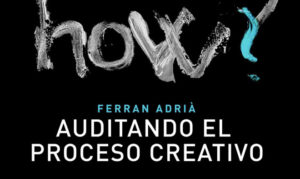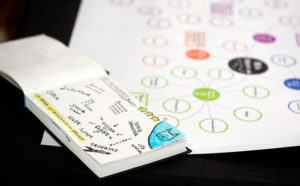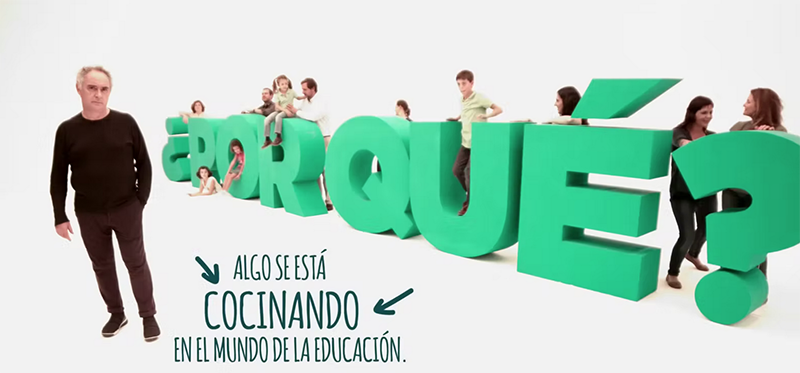You’re crazy!!! It has never been done like this!!!! Don’t complicate your life! These are the warnings that creative and innovative minds must listen to in a weary litany throughout their lives. Why do things differently when it is much more convenient to continue doing them as usual? However, thanks to curious people, inquiring and passionate minds, we have left the prehistoric cave and reached into space; we transplant hearts and rub shoulders with artificial intelligences several times a day.
“Faced with the many challenges of the future, education is an indispensable tool for humanity’s progress towards the ideals of peace, freedom and social justice. If this was true in 1996, when Jaques Delors said it, it is infinitely more true today, when accelerating technological, social, climatic and other changes are reshaping the world order as we have known it. For perhaps a few years ago, uniformity and, to some extent, mediocrity, were desirable in an education system that emerged to support the nascent Industrial Revolution. However, today, creativity and innovative spirit are more necessary than ever, and that is why we must encourage them at school.
In the foreword to the publication Escuelas Creativas (Creative Schools). A journey towards educational change, Ferran Adrià asks himself a fundamental question: Could the creative daring of El Bulli, which revolutionised the world of gastronomy, serve as a basis for starting an educational revolution? This question is the basis of Escuelas Creativas, a joint project between Ferrán Adrià and Telefónica Foundation, the aim of this project being to promote innovation and creativity in schools by applying the elBulli methodology.
The origin of the idea was an exhibition: Ferrán Adrià. Auditing the creative process, a journey in which the spectator was immersed in the creative universe of the Catalan chef. In a space of more than 1,000 square metres, visitors came into contact with the resources, the process, the leaders and the creative culture that enabled elBulli restaurant to develop a creative system of a disruptive and innovative nature (elBullifoundation, 2022). There, as part of the activities, a workshop was held with schools where they were challenged to think about the changes they could make in their school, inspired by Adrià’s creative process. And it worked. Mixing two seemingly disparate worlds, cooking and school, paid off.

The Escuelas Creativas project proposed a challenge to the schools: to adapt the methodology of the elBulli methodology to the education field in order to transform their centres through creativity and innovation. Because innovation and change depend less on laws, reforms and magic methodologies than on educational projects developed by each education community and on professional practices (Escuelas Creativas. A journey towards educational change, 2017).
The schools were asked to present a school transformation challenge, in which they stated what they wanted to change, why and for what purpose. A jury, formed by a committee of experts, was in charge of selecting the participants (17 schools, from different educational stages) that would apply the Sapiens methodology, a research methodology developed by Adrià to create, innovate and reorientate a given reality, based on in-depth knowledge and understanding.
The Sapiens methodology
The Sapiens methodology helps to connect knowledge and serves to understand first and act later. Understanding in order to create. The knowledge and understanding gained will enable us to visualise and subsequently design an innovation and creativity strategy. Sapiens allows you to document, sort and classify. The explanation states it as follows:
- Order: order is efficiency. Knowledge and data have to be ordered: the elements, the objectives, the priorities…
- Contextualise: once we have sorted all the information, we must carry out an exhaustive analysis of the information in order to delimit our objective.
- Classify: for information to become knowledge it has to be accessible, i.e. it has to be classified. “Classifying all the elements of the same discipline or field allows us to know what we know and what we still don’t know”, states the Sapiens Understanding in order to create.
- Imagine: in order to be able to analyse your objective well, you must imagine how it has reached the present moment and what the tools and techniques used to achieve it might have been.
- Create: do you know the thousand forms that the famous tomato bread recipe can take? A simple element such as tomato can be presented in different ways: creating tomato foam, crispy tomato, tomato mousse, among others… Let’s apply this example to our problem or objective.
- Understand: understanding in order to create culminates in the creation of a map. In order to have a global vision of the whole process, we would create a map with all the concepts we have just mentioned. The map allows us to establish relationships and observe them in order to imagine disruptive or innovative possibilities.
The selected centres analysed their strengths and weaknesses and set themselves a strategy with a major objective. For example:
- The School of Art and Design of Soria wanted to change their teaching methodology to make it less traditional and more participative. To this end, they created a centre project that took the school’s activities outside the school. Go out into the street and use the city as a “learning laboratory”.
- In the Enrique Tierno Galván Secondary School in Moncada, Valencia, Spaintheir challenge was to change the physical space of the school, making it friendlier and less grey, in order to improve the atmosphere of coexistence in the school. To this end, they created an open classroom in the courtyard, in which they have involved the whole municipality.
- In the special education centre Eusebio Martínez of Alcantarilla, in Murcia, they set themselves the challenge of creating a laboratory, the EusebioLab, to investigate through art and its impact on the development of pupils’ abilities. They sought ways for their pupils to make themselves seen and heard through performing, visual and plastic arts.

However, the main objective of the proposed project was focused on the improvement of the individual pupils. Hence, it makes sense to promote a vision of transformation and educational change that seeks to turn towards creativity, a central element in the evolution of the human being. It implies, therefore, knowing how to promote the ideas that we have, to promote teamwork, to improve knowledge of the centre, to know where we are and where we can go, to seek teaching through and with creativity, to recognise the need to think and debate, to better manage change, to mobilise the teaching staff and the education community (adding views and talents), to be more creative in the processes, to learn from mistakes and to learn that the evaluation of creativity is a critical path to grow as free and empowered people
One of the most decisive aspects of the project was the involvement of teachers and education professionals in the adaptation and development of the support materials and in the process of accompanying and advising the centres. All this work was translated into the development of support materials designed by educators and education professionals for educators and other education professionals.
Among the materials, five guides that have translated the ideas on innovation and change and on the creative process developed in recent years by Ferran Adrià and elBulli Foundation into language and educational practices are particularly noteworthy.
The guides aim to help and support schools and teachers in the processes of change and innovation. Help them to generate creative learning ecosystems. We can group them into two blocks: according to whether they are oriented at the level of the centre (Centre Sapiens, Centre Genome), or at the level of the classroom and teaching/learning processes (EduSapiens, My Creative Genome, Learning Menu). What are they and how can they be used to transform education?
Centre Sapiens
It is a useful guide for anyone who believes that creativity and innovation are the levers that move us forward as a society and as individuals. Its aim is to promote and encourage the transformation of educational centres by helping their teachers, management, administration and innovation teams in their transformation processes. It starts from the need for a deep understanding of what I want to transform. It is designed to help generate and implement a transformation plan in educational centres and institutions and has complementary material that facilitates reflection, efficiency and creativity in the different steps of the process.
Centre Genome
It is aimed at all members of an educational centre and its objective is to reflect on the creative personality from three perspectives: the creative personality of the leader, that of the team and that of the education community as a whole.
EduSapiens
It is primarily intended for teachers, and in that sense it provides a step-by-step approach to the design of educational experiences, but also offers many tools for classroom application by students.
My Creative Genome
It is mainly designed for teachers, who trust in the creative potential of their students and, in this sense, it is a step-by-step proposal for the design of educational experiences, and offers many tools for its application in the classroom by the students. It provides a series of proposals so that students can carry out a self-assessment and discover the creative superpowers they have, become aware of their creative potential and that these can be trained and improved through everyday classroom experiences.
Learning Menu
It is a guide for teachers that aims to help them to program in a divergent way and to question classroom practices, losing the fear of being creative in lesson planning. This guide includes some of the creativity techniques used at elBulli, adapted to the education field: inspiration, adaptation and association.
Just over 30 years ago Ferrán Adrià started a gastronomic movement that completely disrupted the foundations of cuisine as we had known it up to that point. In 2014, he decided, in collaboration with Telefónica Foundation and a group of educators, to bring the fundamentals of their creative revolution to the world of education. Today all these materials are available to all those who want to put them into practice






